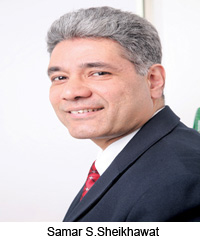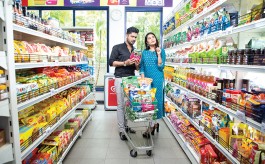High on the young
By N Jayalakshmi | November 25, 2012
In a chat with Point Of Purchase, Samar S Sheikhawat, Senior Vice President, Marketing, United Breweries Ltd, shares his thoughts on the brand approach to retail, the changing shopper dynamics and connecting with them, and a lot more…

Q. To begin with could you share with us your whole
approach to retail
When it comes to retail in this business, the point
is that the government controls the liquor business and each state has a
different model when it comes to distribution.
So we go to the market, make sure product are available and get them displayed. This is one of the reasons why we have the
visi-cooler purity programme to make sure our visi-coolers stock only our
products. Our visi-cooler purity is one of the highest at 90%
Q. Could you elaborate a bit more on customization ?
Each market has it own dynamics. Delhi for example,
is much bigger but has very few liquor outlets. Bangalore which is smaller, has
a lot more outlets. But also in Delhi each store sells many times more than in
Bangalore. Moreover Delhi is much hotter
and therefore cold storage is a must there. We thus plan the strategies
accordingly. We have a team to check and replenish the stock. So it's really a
360 degree approach.
Q. What have been the challenges you faced during
the process of having a strong distribution and visibility system in place?
The main challenge is that the look and feel of
retail is still the same. In some cities like Bangalore though this is changing
with more MT formats stocking liquor, but generally it varies across different
regions. So this requires our sales persons to have the right set of skills to
approach and deal with different kinds of people. Also, given the limited
number of outlets compared to other business , the volume of sales from each
store is higher. So the challenge is to
have the right manpower infrastructure to travel across the geographies and
deal with different kinds of
distributors - from the top end to the low end.
Q. How challenging is to find vendors / partners to
handle in-store visibility?
That is not so much a challenge since the approach
is closer to the FMCG industry which already has a system in place.
Historically this industry is not allowed to go beyond events, promotions etc. So retail is the key driver and where
visibility is concerned, there is a skill set we have already developed. It's a
given. And most people who are associated with us stay for a long time whether
they are partners, employers, or vendors etc.
This is a business that needs a lot of understanding. It takes years to
develop the right mindset and skillsets and once developed, and this is also a
segment where skills get rewarded.
Q. How equipped are retailers in terms of offering
informed guidance to shoppers where liquor, especially wine, is concerned?
After all, this affects your brand ultimately...
Retailers are smart. A small store owner selling
liquor will probably know a lot more about wines than we expect and he also
knows his customers well. But in the
case of MT, revenues from liquor is only about 10 to 15% of the total revenues
. The margins are not high. There the
main revenue comes from vegetables, fruits and groceries. And for MT, liquor is
less than 2%, so the prirority there is not very high. But the situation will
change and once it does, there will be more retailer training programs and
seminars.
There is also change on the part of buyers and the
buying is getting closer to FMCG buying. More number of women now buy liquor
and consumers ask for specific brands and buy 6 packs. There is greater
awareness. So yes trade has to change the way the consumer mindset is changing,
so our sales team in turn has to match that.
Q. What does the new FDI policy mean to you as a top
liquor brand?
The FDI policy is a classic case of too little too
late. First of all, where is the space and the land to put up new MT formats?
Also, doing business in India requires an understanding of the system here.
MNCs will think twice before entering as questions still remain regarding the
commitment of the government to the policy, the clearance from the state, the
laws, the land issues, etc. You see in
India, organized retail in lifestyle and apparels happened much before it
happened in groceries, while in the rest of the world, it's been the other way
around. There people had gotten used to buying groceries from the supermarket
stores much earlier. But here we are still not that comfortable buying veggies
and fruits from MT. The neighbourhood
kirana offers more conveniences. So there are too many dynamics at play
and a lot more needs to be done than just clearing FDI. Retail is not even
recognized as an industry as there is no contemporary Retail Act. But on our
part we are keeping our ears close to the ground because organized retail in
liquor is developing at a different pace in different places, so we are keeping
a close watch on it. And we are already beginning to intervene through lovely
FSUs, and exclusive people to serve those chains and a greater focus on
investment in promos, activations, visibility etc in those places. We are also
looking at consumer feedback to improve the quality of people coming there.
Q. Of your marketing budget what % age is spent on
retail?
The total spend on retail including on-trade an
off-trade visibility and activations
would be 35-40% .
Q. What is your focus on shopper study?
We do a lot of work
with companies such as Nielsen and have a robust research team gathering
a lot of consumer and shopper insights.
We commission studies once in 2-3 months and some of them are very
specific. At any given time we have about 5-10 studies going on.
But these are still early days, as MT facilitates
these studies in a much better way and that format itself is small. We are nevertheless
doing some good research there.
Q. What are the changes that you see based on these
research insights and how do you weave them in your activations?
Over the years we see some changes in terms of
consumer expectations, familiarity with multiple brands, purchase drivers etc.
We find that price is increasingly not a deterrent. Also, younger people today
are not afraid to experiment. So some of the consumer psychographics are
changing and we keep studying other industries too. For eg, we found that the average age of a
Mercedes buyer in India today is 34! So aspirations in the younger consumers
are much are higher. Also smaller towns
are spending more on luxury brands and pubs and there they have lot of aspiration
with not enough access. Our growth is very robust in smaller towns.
Based on all these, we have a robust digital
marketing programme on social networking platforms. We are the No 2 liquor
brand in India on Facebook, and the No 3 beer brand on Facebook. So with
digital we have doubled the budget. We are also looking at mobile platforms and
such devices of the future though at present we are not allowed to do e-comm,
but once that changes, it would be a win.
Q. Finally, how do you maintain your USP given the
increase in competition?
The challenge is to keep the Kingfisher brand
relevant, dynamic, refreshed and focused as far as the new and younger
demographics are concerned. They don't want to drink the brand that their
father drank. So, all our marketing activities are geared towards that






Comments